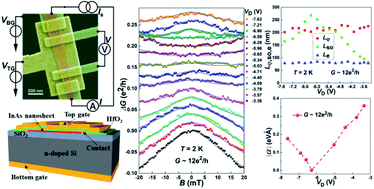Electrically tunable spin–orbit interaction in an InAs nanosheet†
Abstract
We report an experimental study of the spin–orbit interaction (SOI) in an epitaxially grown free-standing InAs nanosheet in a dual-gate field-effect device. Gate-transfer characteristic measurements show that independent tuning of the carrier density in the nanosheet and the potential difference across the nanosheet can be efficiently achieved with the use of a dual gate. The quantum transport characteristics of the InAs nanosheet are investigated by magnetoconductance measurements at low temperatures. It is shown that the electron transport in the nanosheet can be tuned from the weak antilocalization to the weak localization and then back to the weak antilocalization regime with a voltage applied over the dual gate without a change in the carrier density. The spin–orbit length extracted from the magnetoconductance measurements at a constant carrier density exhibits a peak value at which the SOI of the Rashba type is suppressed and the spin relaxation due to the presence of an SOI of the Dresselhaus type in the nanosheet can be revealed. Energy band diagram simulations have also been carried out for the device under the experimental conditions and the physical insights into the experimental observations have been discussed in light of the results of simulations.



 Please wait while we load your content...
Please wait while we load your content...